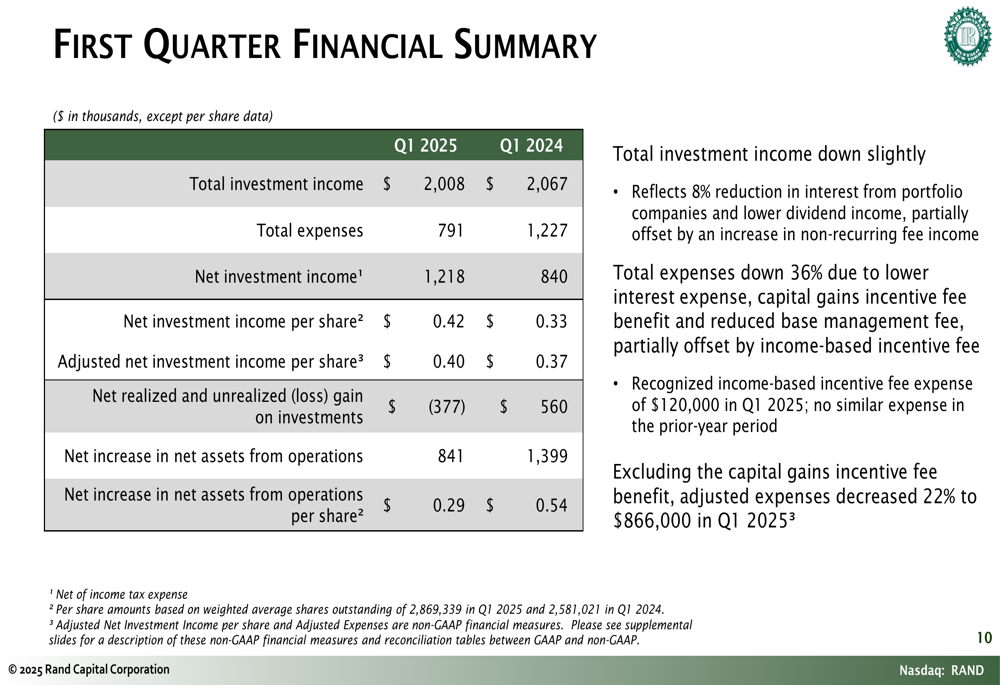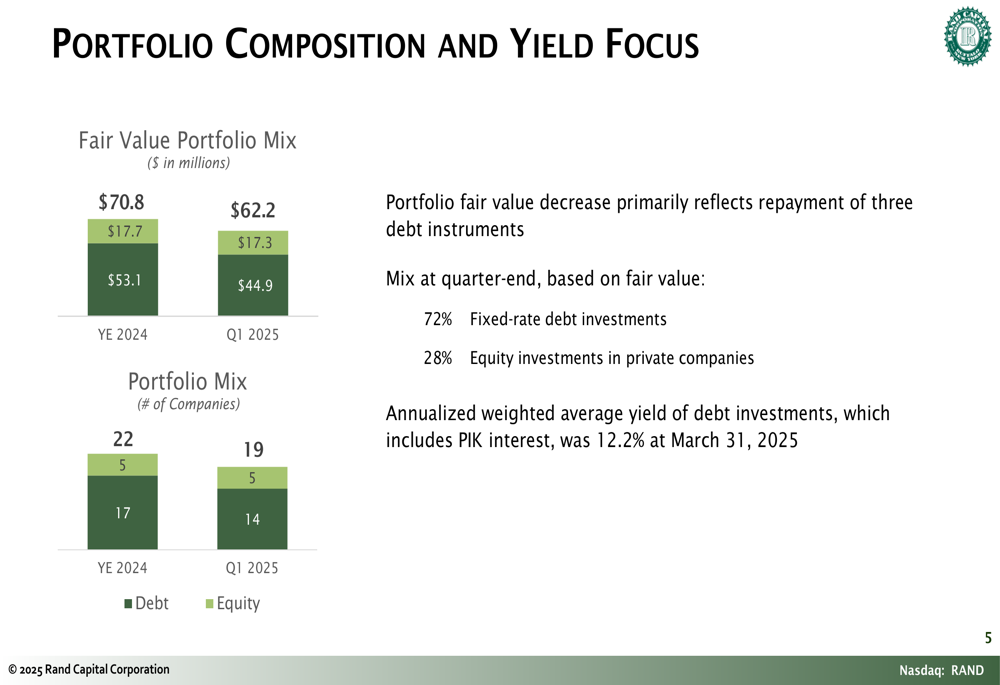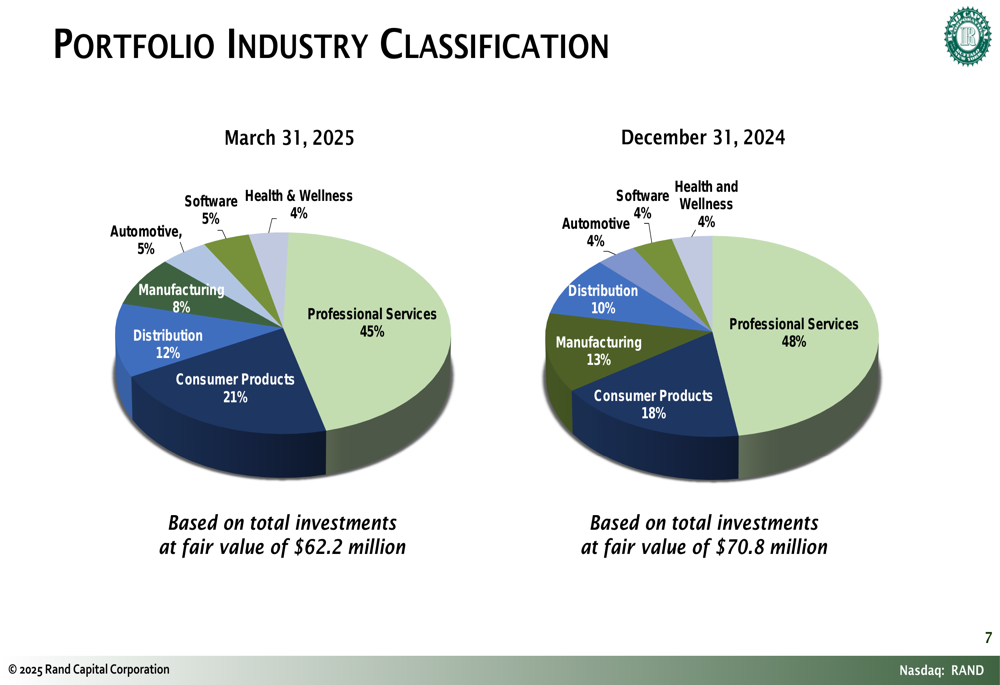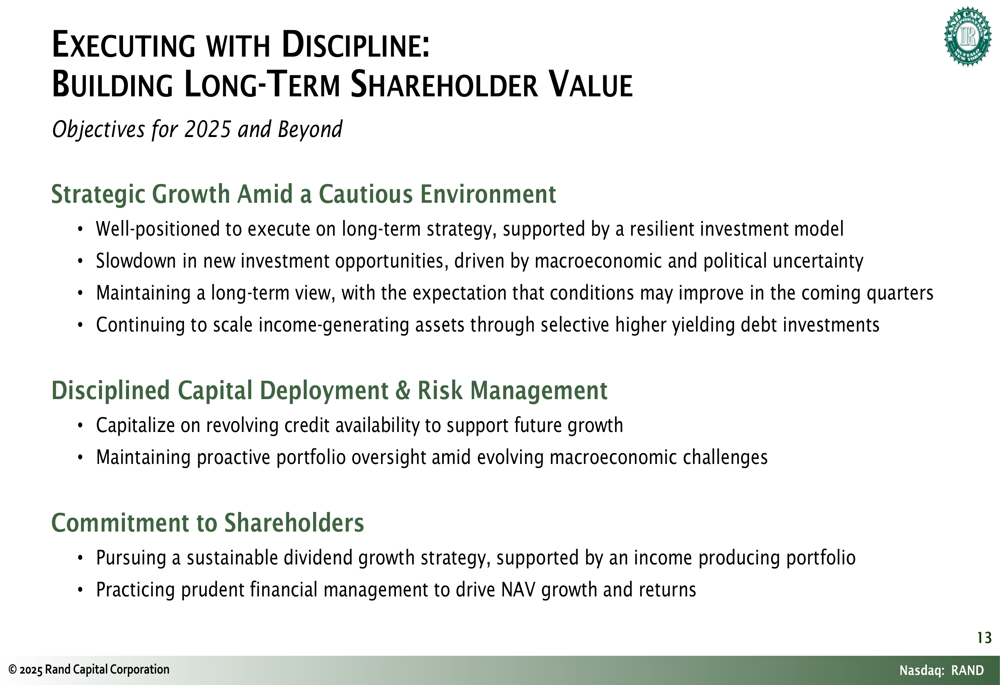Gold prices hold sharp gains as soft US jobs data fuels Fed rate cut bets
Introduction & Market Context
Rand Capital Corporation (NASDAQ:RAND) presented its first quarter 2025 financial results on May 5, highlighting a 45% year-over-year increase in net investment income despite a reduction in portfolio size. The company’s shares closed at $18.88 on May 2, trading at a 14% discount to its net asset value of $21.99 per share.
The BDC (Business Development Company) continues to navigate a challenging economic environment with a cautious approach to new investments while maintaining its commitment to shareholder returns through consistent dividends. The presentation, led by CEO Daniel P. Penberthy and CFO Margaret W. Brechtel, emphasized Rand’s strategic focus on income-generating assets and disciplined capital allocation.
Quarterly Performance Highlights
Rand Capital reported strong financial results for Q1 2025, with net investment income growing 45% year-over-year to $1.2 million ($0.42 per share). This improvement was primarily driven by a significant 36% reduction in total expenses compared to the same period last year. The company maintained its quarterly dividend at $0.29 per share, continuing its commitment to returning capital to shareholders.
As shown in the following financial summary chart:

The company’s adjusted net investment income per share was $0.40 for Q1 2025, compared to $0.37 in Q1 2024, representing an 8% increase. Total (EPA:TTEF) investment income remained relatively stable at $2.0 million, down slightly from $2.1 million in the prior year period. The net increase in net assets from operations was $841,000 ($0.29 per share), compared to $1.4 million ($0.54 per share) in Q1 2024, reflecting a decrease in net realized and unrealized gains on investments.
Portfolio Composition and Strategy
Rand Capital’s portfolio fair value decreased from $70.8 million at year-end 2024 to $62.2 million at the end of Q1 2025. This reduction was primarily due to the repayment of three debt instruments. The company’s portfolio now consists of 19 companies, down from 22 at the end of 2024, with a strategic mix of 72% fixed-rate debt investments and 28% equity investments.
The portfolio composition shift is illustrated in this chart:

During the quarter, Rand made a follow-on debt investment of $375,000 in ПА Window Fashions, bringing its total investment in the company to $2.0 million. The company also exited three investments: Mattson Avenue (full repayment of $5.6 million debt), Pressure Pro (full repayment of $1.7 million debt and a realized gain of $870,000 through warrant sales), and Hilton Displays (full repayment of $1.1 million debt).
The company’s portfolio remains diversified across various industries, with Professional Services (45%) and Consumer Products (21%) representing the largest sectors:

Rand’s top five investments account for 58% of its total portfolio, with Tilson representing the largest position at $11.5 million (19% of the portfolio):

Financial Analysis
Rand Capital’s balance sheet remains strong, with $4.9 million in consolidated cash, up significantly from $835,000 in the prior year. The company repaid its revolver debt and now has over $22 million in credit capacity available for future investments. Net Asset Value (NAV) per share stood at $21.99 at quarter-end.
The following chart illustrates the changes in Net Asset Value during Q1 2025:

Total assets of $67.8 million decreased 6% year-over-year, reflecting the company’s cautious approach to new investments in the current economic environment. Despite this reduction, Rand maintained strong liquidity and financial flexibility.
The company’s debt investments continue to generate attractive yields, with an annualized weighted average yield of 12.2% at March 31, 2025, including payment-in-kind (PIK) interest. This high-yield debt portfolio supports Rand’s ability to maintain its dividend payments to shareholders.
Forward-Looking Statements
Rand Capital’s management expressed a cautious outlook for 2025, noting a slowdown in investment opportunities due to economic and political uncertainties. Despite these challenges, the company remains well-positioned to execute its strategy of scaling income-generating assets while maintaining disciplined capital deployment and risk management.
The presentation highlighted Rand’s commitment to shareholders through a sustainable dividend growth strategy and prudent financial management. The company continues to focus on proactive portfolio management and capitalizing on its revolving credit facility when attractive investment opportunities arise.
As shown in the company’s strategic roadmap:

While Rand did not repurchase any shares during the quarter, it maintains an outstanding share repurchase program of $1.5 million, providing additional flexibility to return capital to shareholders if market conditions warrant.
In the current environment of potential interest rate reductions, Rand’s strategy of focusing on fixed-rate debt investments (72% of the portfolio) positions the company well to maintain stable income streams, supporting its dividend policy and long-term shareholder value creation.
Full presentation:
This article was generated with the support of AI and reviewed by an editor. For more information see our T&C.
